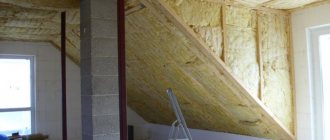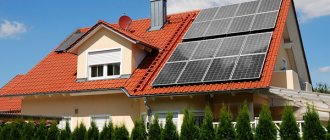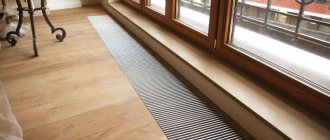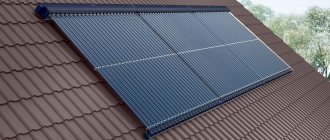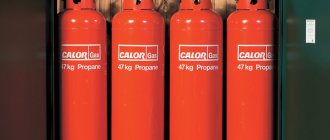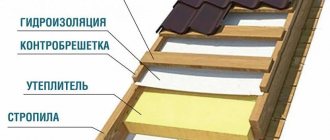To get free electricity from solar energy in their own home, many people are increasingly using solar panels.
Most often they are placed on the roof. Next, we will provide a full calculation of the price of the equipment and examples of installation with step-by-step photos. To determine the approximate number of solar modules, assume that a family of four lives in a house. It consumes about 3000 kW of electricity per year (this is confirmed by average data). Based on this, a 5 kW photo battery is selected.
Required number of photocell cells
In single-family houses, polycrystalline panels with a power of 240-260 W are most often used (they are characterized by a relatively high efficiency of 18%, and their price is not high). If you choose 250W modules, you will need 20 solar panels, which take up about 35 m2 of roof area.
Attention! Roof panels should be positioned so that they are not obscured by a chimney, tall tree, electrical tower or adjacent building. This may cause overheating and damage to the module.
Therefore, manufacturers equip their panels with shunt diodes (from one to four). When one row of cells is shaded, the diode starts to work, then current flows using a bypass (English bypass - backup path, backup route to ensure continuous operation of the system).
Connecting multi-directional elements
When using a sequential solar panel installation scheme, in order not to reduce the efficiency of the devices, all panels of the common circuit should be placed at the same angle and on the same plane.
If the panels are located in different planes, this may lead to the fact that the closest or more illuminated one will work more powerfully than those located a little further away.
This means that the near panel will generate electricity, some of which will be released to heat the distant panels. And the reason lies in the fact that current flows along the path of least resistance. To minimize losses, it is better to use a separate controller for each panel.
The main requirements when using the controller are the power of the connected panels over 1 kW and the distance between the batteries at a sufficiently large distance
The issue can also be resolved by installing cut-off diodes. They are placed inside between the plates. Thanks to this, while delivering maximum power, the plates do not overheat.
The voltage drop in the connections, as well as the wires themselves, of the low-voltage part of the system is also important.
Table of discrepancy between the transmitted power and the wire cross-section, indicating in red the parameters at which there is a risk of strong fire heating
An example is the fact that on a meter piece of cable with a cross section of 4 mm2, when a current of 80A (voltage 12 V) passes, the values drop by 3.19%, which is 30.6 W. When twisting is activated, the voltage drop can vary from 0.1 to 0.3 V.
Price Costs of Photovoltaic Panels
Material prices are approximate because the cost of panels, inverter or mounting structure is greatly influenced by the type of devices selected, brand and manufacturer. Since most devices are imported from abroad, the current dollar exchange rate is also important.
Example of a list of materials for a 5 kW photovoltaic installation:
- Photocell system consisting of 20 250 W modules – 200,000 rubles;
- Fastening of aluminum profiles on a sloping roof covered with tiles - 50,000 rubles;
- An inverter that allows you to control the installation - 50,000 rubles;
- Connectors and fuses - 10,000 rubles.
- Installation of solar panels takes up to 5 days, for which we will pay the craftsmen 100,000 rubles;
Attention! This specification does not include the cost of batteries as they are an optional option in a solar power plant. An independent installation for a home, due to the need to store electricity, a different type of inverter and slightly more panels, will be 40% more expensive.
In autumn and winter, on cloudy days, the efficiency of a photovoltaic system decreases by approximately 50%.
Useful: Replacing an electrical outlet in an apartment with your own hands
Quick Basics: What Solar Panels Are and How They Work
Solar batteries are modules that consist of several dozen photovoltaic cells connected in series or parallel. As soon as light hits a photovoltaic cell, it begins to produce electricity, and the more intense the light, the more electricity can be produced. In central Russia in the summer, high-quality solar panels for a home can produce about 150 W/m2 at peak and about 120 W/m2 under normal conditions.
The principle of operation of solar panels
Light is a stream of photons, elementary particles with low energy. When light hits a solar cell, the material that makes it up absorbs a small number of photons. Because of this, electrons are released and an electric current arises between the contact layers. And although the energy of each photon is small, there are many of them, so solar panels on the roof of a private house can produce thousands of kilowatts, and the power of large solar power plants amounts to megawatts.
A solar cell consists of seven main layers:
- anti-reflective glass;
- facial contact;
- n-type silicon;
- separating layer;
- p-type silicon;
- back contact;
- substrate.
The top anti-reflective layer protects the photovoltaic cells from damage and moisture, while simultaneously increasing the light-absorbing ability of the panels. It is because of glass that many solar panels have a characteristic blue color. Two types of silicon are needed to create a potential difference when electrons are knocked out by photons. This potential difference is removed from two contacts - front and back - in the form of a direct current with a voltage of about 0.5 V. The substrate is the basis for mounting solar cells, which, like glass, protects the panel from moisture getting inside it.
Due to such a simple design, solar panels have a long service life - 35-40 years. Moreover, the degradation of high-quality batteries is largely due not to the destruction of silicon crystals, but to the darkening of the EVA lining film, which is placed between the photocells and glass.
Types of solar panels
The vast majority of solar panels are made from silicon (Si), but there are promising batteries made from cadmium telluride (Cd-Te) and copper-indium gallium deselenide (CIS or CIGS). Potentially, they will significantly reduce the cost of a home solar power plant, but this is only in the future. So far, only a few companies in the world produce non-silicon solar cells, and their price per watt of power is higher, so such solar panels are almost never used for home use in Russia.
Regardless of the material, solar panels come in three types:
- Monocrystalline . These solar panels are made from a single crystal of pure silicon. They have the highest efficiency - up to 22% - in bright sunshine, and structure degradation occurs more slowly than other types of batteries - manufacturers provide at least 25 years of warranty on monocrystalline cells.
- Polycrystalline . As the name suggests, these panels are made not from one, but from many multi-directional silicon crystals. This affects both the efficiency - it usually does not exceed 18%, and the service life - polycrystalline panels age faster. Nevertheless, in Russia, polycrystalline solar panels are most often installed on the roof of a private house, since they are significantly cheaper than monocrystalline ones.
- Thin film or amorphous . This type of solar panels is the cheapest because they require the least amount of silicon to produce them. The efficiency of thin-film solar panels of the latest generation is only 8-12%, but they work better than crystalline elements in diffuse light conditions - in cloudy weather or in conditions of shading from a nearby tree, amorphous solar panels produce 10-15% more electricity than monocrystalline modules .
In addition to “pure” panels, the operation of which is based on one type of material, hybrid heterostructure (HJT or HIT) solar cells have appeared in the last few years. They use both crystalline and amorphous silicon simultaneously, which increases the efficiency of the panels and improves their performance in conditions of diffuse light and elevated temperatures.
How to choose solar panels
Most people choose solar panels for their roof in much the same way as they choose a coffee maker or vacuum cleaner. That is, they focus mainly on price, advertising and reviews on the Internet. But this approach is fundamentally wrong: no one expects a vacuum cleaner to last at least 25 years, and all this time working outside under the scorching rays of the sun. With such a long service life, reviews from people who installed solar panels on the roof of their house a maximum of a year or two ago are simply not of any value. Not to mention the fact that this is a non-mass product, which is why reviews from real people are literally drowning in the mass of custom ones.
Therefore, when choosing a set of solar panels, we recommend taking into account the following characteristics:
- Manufacturer . This is the key factor. The solar battery manufacturer must be included in the rating of the largest ones and, preferably, it must have a full production cycle: from silicon to the batteries themselves. Yes, you will have to overpay for branded panels, but relatively little - 10-15%, while when buying noname panels there is a risk of losing the entire amount. At the same time, you should not be afraid of Chinese manufacturers; large companies like JA Solar, Suntech or Helios House produce high-quality solar panels. Although, of course, it is better to choose European or North American companies: First Solar, Canadian Solar, Solarworld, Viessmann Group. Solar batteries from Japan and South Korea also have excellent characteristics: Hanwha Solar One, Sharp, Kyocera, Sanyo.
- Tolerance . This is the difference between the rated and actual power of a solar battery. If the actual power is less than the rated power, then the tolerance is negative; if it is more, then it is positive. The tolerance must be zero or positive, because with negative tolerance you are still paying the full price, that is, you are paying for non-existent watts. For cheap panels, negative tolerance is acceptable, but only if it is no more than 2-3%. This means that with a rated power of 100 kW/m2, the panel should produce at least 97-98 kW/m2.
- Temperature coefficient . As the temperature increases, the power of the solar panel decreases. The temperature coefficient represents how much power will drop as temperature increases, so the lower it is, the better.
- PTC value . In order for solar cells from different manufacturers to be compared, they are tested under standard conditions (STC). These conditions are far from realistic, so an independent PTC standard has been developed that better reflects the operating conditions of the panels. The closer the PTC/STC ratio is to one, the better the solar panel will perform on the roof of your home.
- Efficiency of panels . Everything is simple here: the higher the efficiency, the better the panels convert solar energy into electricity. An efficiency of 15% is considered acceptable, but the optimal figure is higher - 18-20%.
- Guarantee period . We have already talked about the 25-year warranty on the panel. This is the minimum period and the de facto industry standard. Therefore, if you want to buy a solar panel for your home rather than a portable solar module for camping, pay attention to the warranty period and always read the terms and conditions carefully.
Now about the price. For most people, this is the main parameter of the system, but we recommend looking at it last. Over a long period of decades, branded and expensive equipment often turns out to be more profitable than cheap ones. Such solar panels age more slowly, produce more power per unit area, and often have not even zero, but positive tolerance. All this in total compensates for the high initial cost after 5-8 years of operation. Of course, we are talking about justifiably expensive equipment. For example, it is better to buy a solar panel for the roof from monocrystalline elements from a top manufacturer than the same panel manufactured by a small company. If you buy panels that are made using the latest technology or fashionable modules in the form of tiles and other roofing materials, then this can hardly be called a rational purchase.
Also, don't look at the price of the entire battery, but at the cost of 1 watt of energy. This is a more informative indicator, since the power of solar panels of the same size, but from different manufacturers, often differs by tens of percent.
What affects the performance of a solar power plant
The maximum performance of a home solar power plant is limited by the performance of the solar panels. But how much electricity the system will generate in real conditions depends on a number of things that are not always obvious to the buyer.
Equipment quality
In addition to the solar panel itself, a home SES includes at least two more devices: a controller and an inverter. And usually they are selected on a residual basis. Because of this, losses on them can reach 20-25%. That is, you will receive only 75% of the energy generated by solar panels only because you did not pay enough attention to the choice of the inverter and controller. For comparison, according to the standard, losses should not exceed 5%.
A high-quality inverter is, first of all, a device with high efficiency - from 95%. Moreover, this must be real efficiency, and not just numbers on the case. For example, medium and small Chinese manufacturers often overestimate the performance of their inverters, but in reality their efficiency can be 85% or even 80%. Therefore, it is better to choose controllers and inverters from European, Japanese or American manufacturers. Products from Chinese factories, with the exception of very large manufacturers, are worth buying only if it is possible to check whether the real efficiency corresponds to the nominal one.
In addition, over time the inverter and controller will need to be changed. And the better quality it is, the later such a replacement will be needed. For example, top-end devices are replaced after 15-16 years, while cheap inverters often fail without serving for even 5 years.
Location
The efficiency of converting solar energy into electrical energy depends on the angle at which the sun's rays strike the panel. In Russia, this angle is maximum if the panels are directed strictly south. In this case, the home solar power plant will produce the greatest power. The southeast and southwest directions are a little worse, but this is also a good option - the power will be lower, but not significantly. Directing the panels to the west, east and, especially, north is undesirable due to a strong decrease in the performance of a home solar power plant.
If the slopes of the house are directed to the west or east, then it is more profitable to place the panels directly on the ground. This installation of solar panels is a little more expensive due to the pouring of the foundation and the need for a powerful frame, but these costs are offset by the greater productivity of the panels.
Insolation level
Not all regions of Russia are suitable for installing solar panels. In the north of the country, including St. Petersburg, insolation levels are too low for solar panels to have acceptable efficiency. This, again, is related to the angle of incidence of the sun's rays, only this time not horizontal, but vertical. And the closer to the south, the higher the sun is above the horizon and the more sunny days there are.
In addition, the angle of inclination of solar panels also depends on geographic coordinates. In the north they need to be placed at a large angle, and as you move south this angle decreases until it becomes almost zero at the equator.
Regardless of the level of insolation, the output of solar panels can be increased by installing them on turntables and connecting them to a sun tracking device. The device rotates the solar panel during the day so that it, like a sunflower, is constantly facing the sun. To do this, the panels are mounted on a holder that is parallel to the polar axis. This is the installation method described by the last line in the table. Rotating devices are very effective, but they are also expensive, so solar panels for the home are rarely equipped with them.
Shading panels
Have you built a house right in the forest in the shade of tall trees? Congratulations - it’s beautiful and environmentally friendly, but it’s unlikely to be possible to install solar panels on the roof of such a house. More precisely, they can be installed, but the effectiveness of the panels in the shade is low. The same applies to any other shadow, for example, from a nearby apartment building or a neighbor’s large cottage. If there is shading, then you need to either remove the obstacle, for example, a tree, or install the panels not on the roof, but on the sunny part of the garden plot.
How much can we save on a photovoltaic battery?
Considering the significant investment in a photovoltaic installation, we are interested in how much we will gain in price from its implementation. Assuming that a 5-kilowatt mini-power plant will be installed in a house located in central Russia and will generate 4,500 kWh of electricity per year. This corresponds to the average electricity demand for a family of four.
Therefore, if we pay 6 rubles. per kW/h, we will save about 20,000 rubles. This provides reimbursement after approximately 12 years.
This calculation applies to current prices (as of early 2022) and current regulations. It is difficult to predict how things will change in the near and distant future.
Combination of solar energy and stationary network
When planning to use electricity from the sun in parallel with an equipped centralized stationary network, the connection diagram is made slightly different. And the main reason for this decision is that the private consumer does not have the opportunity to “dump” the remaining energy.
And this can provoke voltage surges lasting up to one second.
When combining solar electricity with a stationary centralized network, they are guided by the same rule: the more sources are connected, the more complex the scheme becomes
According to the above diagram, the voltage from the heliofield is first directed towards the battery, and from there it is transmitted to the load.
When designing this installation option, it is worth taking two types of load into account:
- non-redundant – lights in the house, household appliances, etc.;
- redundant – emergency lighting, refrigerator, electric boiler.
Keep in mind: the larger the battery capacity, the longer the backup electrical appliances will work in autonomous mode.
When choosing this method of generating energy into the network, be prepared for the fact that you will have to apply for permission from local power grids.
Despite the fact that inverters for solar panels produce voltage, the quality of which is sometimes higher than that in the centralized network, local power grids do not give the go-ahead for the electric meter to rotate in the opposite direction.
For this reason, according to the scheme, solar inverters stop working when the voltage in the network is lost. And the redundant load begins to be “powered” from the battery.
Installing solar panels on the roof
Photovoltaic panels on the sloping roof are laid on aluminum profiles. They are attached to the roof structure depending on the type of covering with appropriate fastening elements. Next, we will show the installation of solar panels on a roof covered with ceramic tiles. This type of material is one of the most frequently chosen by investors.
In addition to the solar cells and profile design, other components of the solar installation are located at home. The most important of them is the inverter and protection unit.
Registration of permits
The process of obtaining all the necessary documents consists of several stages.
Stage No. 1. "Legalization" of the roof.
It is the most difficult because it requires the legal transfer of the roof into the ownership of the building's residents. To do this you need:
- obtain an opinion on the suitability of the roof for reconstruction in the form of installing solar equipment (in many old buildings this can be problematic);
- approve the transfer to the category of exploited at a meeting of owners - and the protocol must be signed by all apartment owners without exception;
- a multi-storey building in which solar panels will be installed on the roof can only be transferred to the required category by Rosreestr, where the decision will be approved;
- if one is received, a second meeting will need to be held - now the presence of 2/3 of the owners will be sufficient - where the purpose of using the roof should be recorded;
- the document must be sent to the Institute of Housing Design, where an engineering project will be created;
- the finished document must be approved by Construction Supervision, and then by municipal authorities.
Important! If there are violations in at least one of the listed points, the legalization may be declared invalid, and the station will be forced to be dismantled, and at the expense of the owners.
Stage No. 2. Obtaining specifications for connecting solar panels in a multi-storey building to the power grid
Any solar power plant, according to current legislation, is recognized as a “non-standard electrical installation”. To obtain a permit, owners will need:
- submit an application for connection to networks to the relevant department of the REM;
- a second application for the allocation of additional electrical power to the building;
- all documentation approved at the first stage.
Since there is only one licensing organization, approval usually occurs without problems.
Where to install the inverter (converter)
Although the location of this device is not critical, it is recommended to place it as close to the panels as possible (i.e. in the attic), which will significantly reduce the loss of current during its transmission. The inverter is usually equipped with a display on which all parameters of the operating installation can be read. Increasingly, manufacturers are providing wireless Internet connections, so it will likely be possible to control the system using a computer.
Choosing the right inverter model depends on the type of solar panels and wiring installed in the house - some devices are used in single-phase networks, others in three-phase.
Let's sum it up
Solar panels are a progressive “green” technology that allows you to make your home autonomous and independent of the local electricity supplier. In addition, it can help you save on electricity bills and increase the life of your roof.
When choosing solar panels, you need to consider their manufacturer, tolerance, temperature coefficient, efficiency, PTC and warranty periods. But even the best solar panels will work poorly if you point them not to the south, but to the north, install them in a place where the shadow falls, and save on other elements of the system: the controller and inverter.
The installation of solar panels should be carried out by professionals. But control over the quality of work, as well as the preparatory stage, is usually undertaken by the owner of the house. You need to check the condition of the roof, make sure that it can withstand the additional load and make sure that the batteries are installed on branded mounting kits.
Fuses and connectors
The fuse is located in the main distribution panel, that is, on the electrical panel. It protects the inverter from damage.
In addition, the system has a disconnect switch, which is designed to disconnect the home installation from the external power supply, for example when it is damaged or some maintenance work is being carried out.
Attention! Installation with solar panels must be connected to the network by an authorized electrician. You cannot install such devices into the electrical network without permission - there may be fines, so be sure to invite a local electrician.
Possible technical changes and equipment installation
Let's assume that solar panels in a multi-storey building, which are installed for shared use, have a total power of 15 kW. Then the SEM needs to allocate the same additional power. If the owner of only one apartment decides to install SES, the figure will have to be doubled, to 30 kW - 15 kW separately for the apartment and the same amount for the building as a whole.
Usually a certain power reserve is provided for the home. But if it is not enough, power engineers will have to modernize the switchboard. Then residents will have to pay:
- production of specifications for such modernization;
- installation of new cables;
- new three-phase meter;
- roof repair (if necessary).
Where to begin?
There are always at least two ways to solve any problem: study yourself or entrust the solution to someone else. The first option involves studying theoretical materials, reading forums, communicating with owners of solar power plants, fighting internal toads and, finally, purchasing equipment, and then installation. The second option: call a specialized company, where they will ask a lot of questions, select and sell the necessary equipment, and maybe install it for some money. I decided to combine these two methods. Partly because it’s interesting to me, and partly in order not to run into sellers who just want to make money by selling something that’s not exactly what I need. Now it's time for theory to understand how I made my choices.
The photo shows an example of “using” money for the construction of a solar power plant. Please note that the solar panels are installed BEHIND the tree - so no light reaches them and they simply do not work.
Application area
Solar batteries, or as they are sometimes called solar panels, can be used to provide electricity to cottage villages, dacha cooperatives, and industrial enterprises.
They are very effective for sanatorium complexes, hotels, hospitals, buildings located far from main power lines.
We can say that they are needed where there is a need for another source of energy and where it is possible to install them. At the moment, solar panels are installed on the roofs of buildings and houses, and they are installed in deserts and on trains. There are even completely autonomous solar-powered houses.
The production of solar panels is proceeding at a gigantic pace and the leaders in this industry are China and the USA. Germany, Gulf countries, Western Europe and Scandinavia.
Principle of operation
In fact, the correct name is photocell (that is, photobattery). But since the light source is the sun, the name “solar battery” has stuck.
The element is a “sandwich” of silicon wafers separated by a standard (for radio components) junction. The secret is that the silicon parts are of different types:
- N-layer;
- P-layer.
Such kits are used in almost all radio components made of silicon.
This is interesting: Many of the standard radio components can also generate electricity when exposed to bright light. It’s just that the efficiency is so meager that using them as a current source is pointless.
Phosphorus is added to the N-type silicon layer. At rest, such a mixture produces an excess of electrons with a natural negative charge.
The P-type is “enriched” in boron, which creates a deficiency of negative charges (the so-called electron hole effect).
Accordingly, a negative electrode is connected to the N-layer (to remove electric current), and a positive electrode is connected to the P-layer.
From the laws of physics we know that there is an electric field in the P/N junction. Under the influence of solar photons on the negative panel, intensive separation of negative and positive particles occurs in the transition. The “cons” accumulate in the top layer, and the “pros” in the bottom. As a result, the solar sandwich turns into a regular battery with accumulated charge. If you connect an energy consumer to the electrodes, an electric current occurs.
Naturally, the charge in such a source instantly disappears, but it is immediately restored by sunlight. Thus, while the photobattery is intensively bombarded by photons, we have a fairly productive mini power plant.
Modern batteries can work even in the absence of direct sunlight (for example, in completely cloudy conditions). Naturally, the intensity of electricity generation decreases. But in the absence of light (even the moon is not able to “awaken” the battery), the process stops. Therefore, it is impossible to consider photo panels separately as a source of electricity. The connection diagram for solar panels necessarily includes a buffer device: an energy accumulator.
In addition, the generated current is unstable, so a control controller is required to organize the power supply of the facility. Of course, if you are using a mobile photo battery to charge your smartphone on a multi-day hike, such technology is not required. And to build an individual power plant, a set of peripheral devices is required.
How to avoid common mistakes?
When assembling and installing, pay attention to the following nuances:
- There is no need to assemble it on a frame with a back wall made of beams, since the wood can swell and the structure becomes deformed. In addition, the beam makes it very heavy.
- You cannot use plexiglass as a cover, as it overheats and due to this, the contacts between the panels become unusable, and the system itself may depressurize.
- Connecting terminals are not the best option for combining panels with each other, since in case of repair it will be impossible to separate them - it is better to use connectors specially designed for this.
Advantages and disadvantages
Pros:
- At the use stage - environmental friendliness (with a caveat: production and disposal are just as “dirty” as any other electronics).
- After the initial investment, the resulting electricity is conditionally free (some funds are required for maintenance at the end of its service life).
- Full autonomy is possible: you can organize energy supply in places where a centralized power supply is not even planned.
- You do not depend on the tariff policy of energy companies.
- If certain standards are met, it is possible to “sell” excess electricity to city networks.
Minuses:
- The relative high cost of the equipment (as can be seen from the examples of use, this is not always a problem).
- Dependence on weather conditions (in regions where there are few sunny days, use is difficult).
- The equipment needs periodic updating - there is natural wear and tear.
Controller
Let's consider what parameters are used to select a battery charge monitoring unit.
Panel array power
Voltage compliance is required: rated (operating, closed to load) and open circuit (no load, no load).
The product must withstand the highest input current from the SB (the same value in short circuit mode) - this point is rarely indicated in the instructions. To calculate the value, you need to find out the rating of the controller fuse and calculate the short-circuit current of the circuit panels. For solar panels, the latter is, as a rule, always indicated and it is higher than the maximum operating (nominal) one, which also must be taken into account. This is the current of the connected circuit of photocells generated by them during normal operation, and it is lower than that specified in the TD for the controller (manufacturers indicate the maximum value there).
Power rating. This is the product of the operating voltage and the same current of photovoltaic modules. Their power, combined with the controller, must be compared with this rating or be lower, but not more, otherwise the node in question, if it is without a fuse, will burn out. But usually there is such protection, designed for an overload of 10–20% for 5–15 minutes.
Voltage of solar modules and batteries
As standard, there are models for 12, 24 V and two of these indicators with auto-switching. For example, the user can choose the first model if several panels are connected in series (in this case, 12 V will be output). But, of course, it is better to choose a universal device.
These numbers may be too low for high-end systems. To get the desired power, you have to install more panels and batteries, making parallel circuits out of them. The current strength increases significantly, which leads to overheating of the cable and electrical losses. In this case, it is necessary to increase the cross-section of the cores. There is a need for extremely expensive controllers for high currents.
To avoid an increase in the number of Amperes, monitoring units for powerful assemblies are produced at a nominal slave. eg at 36, 48, 60 V, that is, a multiple of 12 V, so that the galvanic modules can be connected in series. Such controllers are created only for PWM charging technologies. They have input. nominal eg from panels and nominal eg The battery circuit should be compared, for example, 12 from SB = 12 V to battery, 24 = 24 V, 48 = 48 V.
MPPT type controllers operate with an equal input voltage or several times greater; there is no multiple of 12 V. Usually they are designed for input from 50 V panels, complex models (powerful systems) can be up to 250 V. It must be taken into account that factories indicate a max. input for example, when connecting galvanic modules in series, they must be stacked max. eg (aka “idle speed”). To put it simply, in. Max. eg any from 50 to 250 V depending on the specific instance. And the nominal or minimum. input eg there will be 12, 24, 36, 48 V. In this case, the output. eg The battery for MPRT models is standard, it can be with auto-detection and support for the above voltage range, and sometimes 60 or 96 V.
MPPT models can be very powerful with input. eg from a solar system at 600–2000 V.
Maximum input current and battery charging current
With PWM controller max. input the current from the photocells goes into the charging current of the batteries, that is, the node cannot charge more amperes than the system connected to it produces. At MRRT everything is different - input. The current of the modules and the output for charging the batteries have different characteristics, but they can be equal if the voltage rating of the modules is equal to the same rating of the battery, but then there is no point in converting MPPT, the efficiency drops. The first characteristic should exceed the second by 2–3 times. If it is lower by more than two times, for example, one and a half times, then the effectiveness drops critically, the same applies when it exceeds three times. The input current will always be equal to or less than that max. exit battery charge.
From the above it follows that the MPRT must be selected according to the maximum charge of the batteries. But in order not to exceed this current, the instructions specify the maximum power of the connected modules at rated. eg battery circuit. Example for a 60 A MPPT controller: 800 W at e.g. Battery 12 V, 1600 - 36 V, 2400 W - 48 V and so on.
Maximum load, charging current, number of batteries
The maximum load, also known as the charging current for batteries, is not a secondary characteristic.
The maximum power at the controller output is taken into account both from its side and from the batteries. For example, there is a set of the latter with a large capacity; to charge during the day, the node must produce the required value. And the same characteristics and capabilities of galvanic cells, naturally, should be no less. If the parameters of both the monitoring unit and the panels are capable of meeting the needs of the battery pack, then it will not have time to charge during the day, which will cause even greater discharge under constant load, and so regularly, which will lead to rapid wear.
The situation if a battery with a small capacity is acceptable. The capabilities of modern controllers eliminate this nuance.
But we will also consider the problems that old, or low-quality, simple controllers had. They had to be selected with equal power. At the same time, for the battery max. the charging current should not be higher than 30% of the nominal capacity, that is, if the last is 100 Ah, then this parameter is not higher than 30 A. With excess system power, the controller would charge the batteries even after they are completely filled, without reducing the charging Amperes or voltage. The electrolyte would then boil.
Modern samples are equipped with a built-in microcircuit that monitors parameters. A charging program is written into their microcircuit, and control is carried out by a shutdown relay. Such a product is capable of adjusting the current and charge voltage.
Battery type
Batteries with different chemical compositions differ in their response to current; they have their own charging programs with several algorithms. The controller adjusts the process, voltage, number of Amperes in accordance with the specified range.
More often, standard controllers with pulse width modulation (PWM or PWM) are used. There are also higher-quality MPPT models with technology for determining the maximum power point from the existing array of panels; it must be said that they also work with PWM technology: first, such a unit selects the maximum value, and then, using PWM, carries out the conversion and charges the battery according to the established program .
Select a product with a program specifically for the type of battery you have: alkaline, nickel, lithium (with its own control unit). The simplest models of controllers have 1 or 2 programs for lead-acid, non-sealed, sealed gel or AGM batteries.
Optionality
The most requested functions are the following (excerpt from the characteristics of an online store product):
Type of regulation, voltage transformation
Based on this parameter, PWM or MPPT models are selected. We have briefly explained how they function. To simplify, for inexpensive systems of standard power the former are taken. The second ones are of higher quality, for expensive or powerful assemblies.
